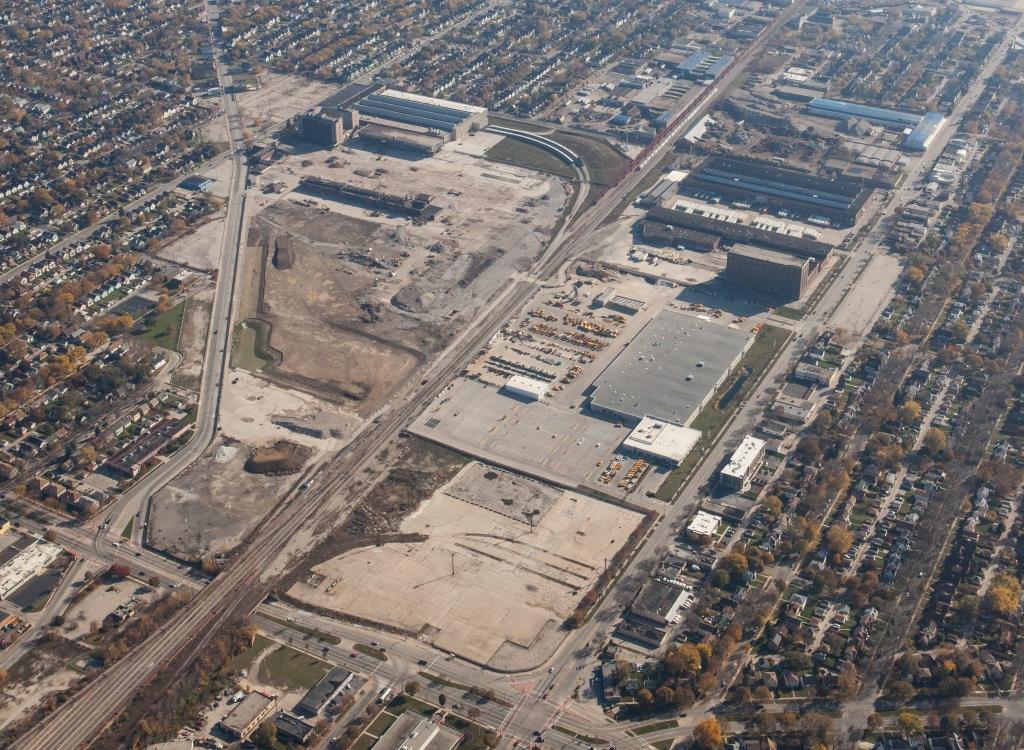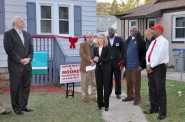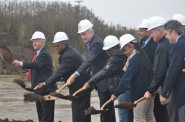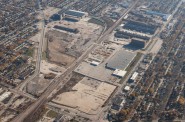How to Design a Public Space
Officials meet with residents about proposed greenway, and the citizens’ suggestions are a surprise.

Aerial view of the 30th Street Corridor. Photo courtesy of the Redevelopment Authority City of Milwaukee.
Last week, the Milwaukee Metropolitan Sewerage District (MMSD) hosted a community meeting at the Holy Redeemer Complex, 3500 Mother Daniels Way, to gather input into the ongoing greenway design of the northernmost stretch of the 30th Street Corridor. The meeting was part of a broad-based, public-private effort to reclaim the 30th Street Corridor, which stretches from Hampton Avenue all the way south to the Menomonee Valley, some four miles long, encompassing 880 acres, or the size of about 660 football fields. Urban Milwaukee has written extensively about this effort.
The issue at this meeting was a proposed greenway which could help reduce flooding in the area. Back in July of 2010, a major rainstorm caused backups into 3,000 basements in the area along the Corridor between Capitol Drive to the south and Lincoln Creek to the north. Nineteen-year old Kyle Prelesnick drowned when his car was swept into the creek.
Jerome Flogel, MMSD’s 30th Street Corridor project manager, led the outreach session, which is seeking input on engineering contractor CDM Smith’s design for the first two retention basins, located east and north of the DRS Technologies property. According to Dan Lau of CDM Smith, the east retention basin (DRS East) would be about one-and-a-half acres in size, and would hold 2.6 million gallons, while the north retention basin (DRS North), at two-and-a-half acres, would hold 6.5 million gallons of water. DRS East, says Lau, will manage the majority of the water retention, holding it and filtering it through the soil, simultaneously cleaning the water and preventing flooding. It will fill a few times a year and will have water in it often. DRS North will be used just for overflow and will only have water in it every few years. When it’s full, it will hold seven to eight feet of water. A third basin, at the site of Bee Bus Lines, will be added once MMSD finishes negotiating its purchase.
The area that incorporates those basins, says Flogel, is about 3,000 acres, and the purpose of the meeting is to get input from the community on what those 3000 acres should look like and what role they’ll play in the community. While much of the engineering is going to be underground, says Flogel: “There are parts you’re going to see and are going to effect you life on an everyday basis and that’s what we want your input on.”
Not everyone in the room, though, was interested exclusively in design. There are also jobs on the table—specifically those created by the dismantling of the houses. State Sen. Lena Taylor (D-Milwaukee) noted that there is a connection between design and the creation of jobs as well. Jose Galvan, Emerging Business Development Supervisor for MMSD, explained that they’re at this meeting not to just talk about the future of the Corridor, but about what’s going on right now. Most of the work associated with the building of the basins is construction work and MMSD wants to be sure that people from the community have an opportunity to contract for the work that’s coming up. “For those of you who represent a small contractor,” said Galvan, “a business, a design firm, whatever it is… these are the areas that we’re looking to focus on and that there are opportunities in.”
MMSD wants to know who’s already in the Corridor, said Galvan, and they’re especially interested in small, women-owned, veteran and minority-owned businesses. To support local and small business involvement, Galvan explained that MMSD offers classes in business, finance and operations management for companies hoping to produce a successful bid for work in the Corridor. “There’s people in these neighborhood who already do this work, who already have this training. We want them to have the first crack at it,” he explained. “We’re out here not just to tell you about this opportunity, but to help you be better at it.
The first of the three meetings seeking input from businesses and residents along the Corridor took place in December 2014. The last will be at the end of the summer when MMSD and CDM Smith will present the final designs. Since the first meeting, Flogel said, they’ve added a new partner: the District 7 local prosecution unit and Assistant District Attorney Ben Wesson. The design for the area north of the Corridor includes a Crime Prevention through Environmental Design (CPTED) analysis. This process, Wesson explained, brings together community stakeholders to provide input into the proposed use of the site and to identify concerns about crime related to the site. The Corridor includes not only District 7, but also District 5 and on its southernmost end, District 3. District 5 is currently conducting an analysis of the site. A lot of the design practices, said Wesson, are common sense, “but we don’t always put it in a package that’s organized and thoughtful.”
Mike Marek of Marek Landscaping, who will be doing the work north of Capitol Drive once the building starts, told the audience that most of the design safety issues are connected to “lines of sight” that create “public surveillance” of the location. Fence height, lighting and vegetation also contribute to the relative safety of a location. “We won’t put up a bunch of pine trees near they edge, because then someone walking along with their family couldn’t see what was going down in the bottom of the basin,” Marek explained. Another tool in preventing crime, he added, is creating an “invitation to use that space.” An inviting and well-used open space brings in people and, “if there are people there then that will help prevent crime.”
The Crime Prevention through Environmental Design analysis, said Wesson, brings in a variety of voices and perspectives, and was used in the the Beerline Trail that connected the Riverwest and Harambee neighborhoods. The perspectives, says Wesson, were amazing. “A lot of businesses said, ‘Okay, if we put a bike trail that goes down this corridor, all of a sudden there’s going to be people behind our business that weren’t there before.” Having the dialogue with those businesses, said Wesson, gave him a chance to explain: “There were people behind these businesses before, you just didn’t know it because no one was looking.” With eyes and ears on a space, said Wesson, “the potential for people to do something nefarious goes down. That space is now a positive space that you can control.”
Before breaking the larger meeting into groups, Marek asked them to think about what the community wants and needs in that space. Big charts of the plans were on the tables and participants can used markers and sticky notes to make additions and draw out their suggestions. Don’t be shy, Marek said. His suggestions for the space included recreational amenities like bike and walking trails and he inquires about interest in sculptures and public art, places to sit and winter activities like sledding. Does the community want public performance space? Boardwalks that go over the water? Should there be an educational component, like the Menomonee Valley’s partnership with the Urban Ecology Center?
After about 30 minutes of brainstorming, the groups all agreed that the space should be multi-use and open to the community. Kids should be able to learn about nature in it. It should have recreation options like bike and walking paths and places to sit at regular intervals for elderly users. Good lighting, a covered pavilion and public art could be included. The groups leaned towards natural landscaping, but were concerned about the costs of upkeep. One group suggested both a climbing wall and a zip line—a suggestion that Marek found especially appealing. Interestingly, no one asked for the features generally associated with traditional urban parks: playgrounds, basketball parks, splash pads, instead favoring design elements that support movement, circulation, inter-generational use, small group gatherings and a place for performances.
Flogel brought the meeting to a close after two hours by expressing his appreciation for the community’s input, and by promising that the partners in the project would continue to improve the process before the next meeting. The big message from this meeting, he said, is that “MMSD and the contractors need to spend more time with the community in the next few months.”
Corridor of Dreams
-
Celebrating the First Homeowner in New Program
 Oct 24th, 2014 by Susan Nusser
Oct 24th, 2014 by Susan Nusser
-
Putting the Pieces Together
 Oct 17th, 2014 by Susan Nusser
Oct 17th, 2014 by Susan Nusser
-
The Land of Brownfields
 Oct 9th, 2014 by Susan Nusser
Oct 9th, 2014 by Susan Nusser





















I love it. Fix what’s wrong. Clean it, green it, put the people to work, make them proud. This is how it’s done!
The MMSD is a leading light on sustainability issues. They apparently are also a leader in community engagement, rather than old-school top-down decision-making.
Government CAN do good things–as long as they to consider “what the community wants and needs.” Go MMSD!